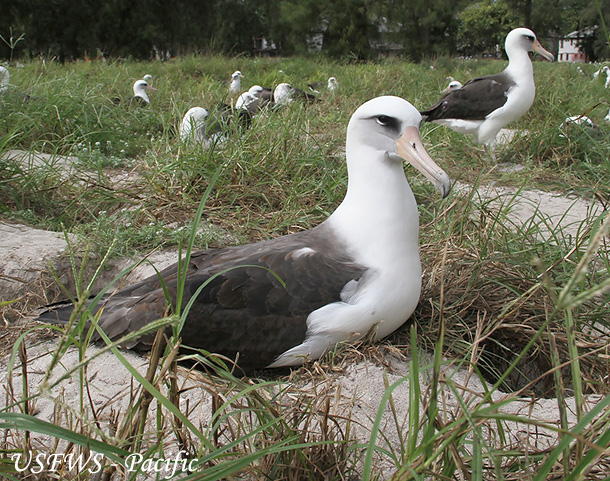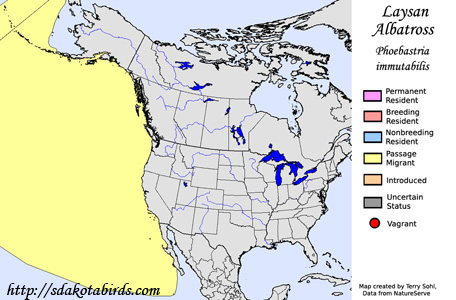| Length: 32 inches | Wingspan: 76 inches | Seasonality: Non-resident in South Dakota |
| ID Keys: White underparts, neck, and head, and tail, dark gray back and wings, dark coloring around eye | ||
 The
Laysan Albatross is the most common albatross species in the Northern
Hemisphere, but at most seasons, they are found well offshore and are not
often seen. They are most easily observed at large breeding colonies,
and approximately 70% of the world's breeding occurs on Midway Atoll in the
Pacific. Laysan Albatross populations plummeted in the 1800s and early 1900s
due to egg collection and hunting, and both drift-net fishing and long-line
fishing have taken a heavy toll since the latter half of the 20th century.
However, populations have rebounded from early 20th century lows. Long-lived
birds, some have been recorded to still be breeding at well over 50 years
old.
The
Laysan Albatross is the most common albatross species in the Northern
Hemisphere, but at most seasons, they are found well offshore and are not
often seen. They are most easily observed at large breeding colonies,
and approximately 70% of the world's breeding occurs on Midway Atoll in the
Pacific. Laysan Albatross populations plummeted in the 1800s and early 1900s
due to egg collection and hunting, and both drift-net fishing and long-line
fishing have taken a heavy toll since the latter half of the 20th century.
However, populations have rebounded from early 20th century lows. Long-lived
birds, some have been recorded to still be breeding at well over 50 years
old.
Habitat: Breeds on flat island areas with expanses of sand and grass. At other seasons, typically found far out at sea, usually away from the shoreline and well off the continental shelf.
Diet: Feeds mostly on squid, but will also feed on fish and crustaceans.
Behavior: Forages by swimming on the water's surface and using its bill to capture prey when spotted. Does much of its feeding at night, when the small squid species it prefers are more likely to be near the surface.
Nesting: The nest of a Laysan Albatross is a simple scrape on a beach or sandy soil, but usually around grasses or other vegetation. The female alone builds the nest, and she lays a single egg. Both the male and female will help to incubate the egg. Both parents take turns feeding the youngster upon hatching, with one parent hunting while the other tends and protects the youngster.
Song: Has a variety of groaning and squeaking calls, mostly commonly heard when birds are grouped.
Migration: In the Pacific Ocean, birds breed in the Hawaiian Islands, Midway, and other islands, leaving their breeding grounds in mid-summer. In the far north Atlantic around Alaska, they are most commonly seen in the summer months. Off the coast of the western U.S., they are most commonly seen in the winter months. However, non-breeding birds may be seen throughout the Pacific at nearly any time of year.
Interactive eBird map: Click here to access an interactive eBird map of Laysan Albatross sightings
Similar Species: Near North America, most likely to be confused with the Short-tailed Albatross.
Conservation Status: In the 1800s, Laysan Albatross populations were decimated by egg collectors and hunters. Drift-net fishing took a heavy toll on the species in the mid- to late- 1900s, and long-line fishing still kills thousands of birds every year. Plastics and other sea trash are also often consumed by the birds and results in mortality. Despite all the factors that have cut Laysan Albatross populations, they are still the most common Albatross in the northern Hemisphere, and populations are higher now than they were in the early 1900s. With all the factors affects populations, though, the IUCN lists the Laysan Albatross as "Near Threatened".
Further Information: 1) BirdWeb.org - Laysan Albatross
2) Cornell's All About Birds - Laysan Albatross
3) Fish and Wildlife Service - Laysan Albatross
Photo Information: U.S. Fish and Wildlife - Pacific photo - Taken on December 1st, 2011 on Midway Island - Photo licensed under Creative Commons Attribution 2.0 Generic License
| Click below for a higher-resolution map |
 |
| South Dakota Status: Non-resident in South Dakota |
Additional Laysan Albatross Photos (coming soon!!)
